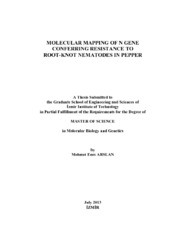Please use this identifier to cite or link to this item:
https://hdl.handle.net/11147/3577Full metadata record
| DC Field | Value | Language |
|---|---|---|
| dc.contributor.advisor | Doğanlar, Sami | en |
| dc.contributor.author | Arslan, Mehmet Enes | - |
| dc.date.accessioned | 2014-07-22T13:51:51Z | - |
| dc.date.available | 2014-07-22T13:51:51Z | - |
| dc.date.issued | 2013 | en |
| dc.identifier.uri | http://hdl.handle.net/11147/3577 | - |
| dc.description | Thesis (Master)--Izmir Institute of Technology, Molecular Biology and Genetics, Izmir, 2013 | en |
| dc.description | Includes bibliographical references (leaves: 31-34) | en |
| dc.description | Text in English; Abstract: Turkish and English | en |
| dc.description | xi, 34 leaves | en |
| dc.description.abstract | Pepper (C. annuum) is one of the most important agricultural crops worldwide and Turkey ranks third among all countries in pepper production. Pepper species have economical and also pharmaceutical importance so, it is vital to develop different methods to increase pepper yields. The root-knot nematode (Meloidogyne species) is one of the most important biotic factors that affect pepper growth and development in Turkey. The dominantly inherited N gene which was mapped on chromosome P9, 7 cM from Me1 and 2 cM from Me3, confers resistance to pepper species against Meloidogyne species. The aim of this work was to develop a marker tightly linked to the N gene which can be used in marker-assisted selection. A total of 132 SSR Hpms primers, 230 EST-SSR markers and 45 chromosome 9 specific primers were used to a construct linkage map and find an N linked marker. Hpms SSR markers gave 19% polymorphism by capillary electrophoresis, EST-SSR markers showed 5.2% polymorphism by agarose gel electrophoresis while the chromosome 9 specific markers, yielded 20% polymorphism by fragment analyzer. When all 407 analyzed markers are considered, only 11.3% polymorphism was observed and these results were expected because we used an intraspecific population. The, polymorphic markers were mapped in a "Carolina Wonder" X "AZN-1" F2 population and analyzed with JoinMap software. Three markers were linked with the N gene. These markers are ScarPM6a (3.6 cM), ScarPM6b (10.2 cM) and ScarN (22.6 cM) which are located with same segregation group with the N gene. These markers will allow development of a marker tightly linked to the N gene which can be used in marker-assisted selection to increase the efficiency and effectiveness of pepper breeding for nematode resistance. | en |
| dc.language.iso | en | en_US |
| dc.publisher | Izmir Institute of Technology | en |
| dc.rights | info:eu-repo/semantics/openAccess | en_US |
| dc.subject.lcsh | Peppers--Genetics | en |
| dc.subject.lcsh | Plant genomes | en |
| dc.subject.lcsh | Plant molecular genetics | en |
| dc.title | Molecular mapping of N gene conferring resistance to root-knot nematodes in pepper | en_US |
| dc.type | Master Thesis | en_US |
| dc.institutionauthor | Arslan, Mehmet Enes | - |
| dc.department | Thesis (Master)--İzmir Institute of Technology, Molecular Biology and Genetics | en_US |
| dc.relation.publicationcategory | Tez | en_US |
| item.grantfulltext | open | - |
| item.openairetype | Master Thesis | - |
| item.languageiso639-1 | en | - |
| item.cerifentitytype | Publications | - |
| item.fulltext | With Fulltext | - |
| item.openairecristype | http://purl.org/coar/resource_type/c_18cf | - |
| Appears in Collections: | Master Degree / Yüksek Lisans Tezleri | |
Files in This Item:
| File | Description | Size | Format | |
|---|---|---|---|---|
| T001110.pdf | MasterThesis | 890.22 kB | Adobe PDF |  View/Open |
CORE Recommender
Page view(s)
580
checked on Jul 15, 2024
Download(s)
526
checked on Jul 15, 2024
Google ScholarTM
Check
Items in GCRIS Repository are protected by copyright, with all rights reserved, unless otherwise indicated.